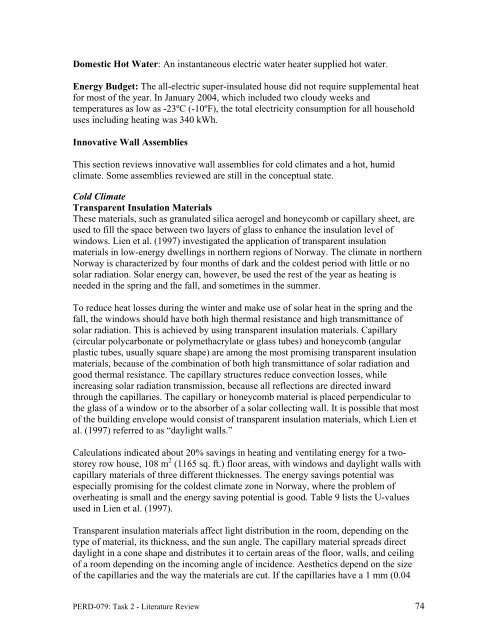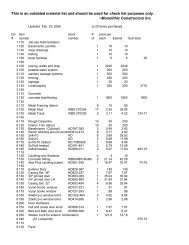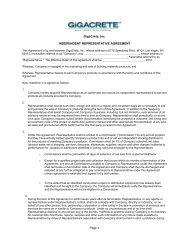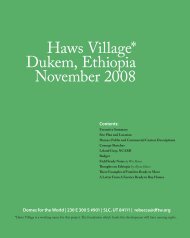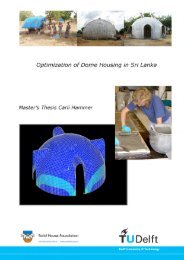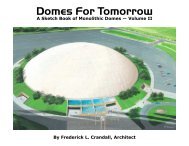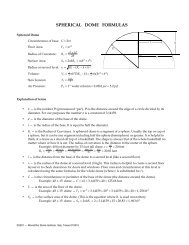Literature Review on Building Envelope, Heating and ... - Beeshive.org
Literature Review on Building Envelope, Heating and ... - Beeshive.org
Literature Review on Building Envelope, Heating and ... - Beeshive.org
You also want an ePaper? Increase the reach of your titles
YUMPU automatically turns print PDFs into web optimized ePapers that Google loves.
Domestic Hot Water: An instantaneous electric water heater supplied hot water.<br />
Energy Budget: The all-electric super-insulated house did not require supplemental heat<br />
for most of the year. In January 2004, which included two cloudy weeks <strong>and</strong><br />
temperatures as low as -23ºC (-10ºF), the total electricity c<strong>on</strong>sumpti<strong>on</strong> for all household<br />
uses including heating was 340 kWh.<br />
Innovative Wall Assemblies<br />
This secti<strong>on</strong> reviews innovative wall assemblies for cold climates <strong>and</strong> a hot, humid<br />
climate. Some assemblies reviewed are still in the c<strong>on</strong>ceptual state.<br />
Cold Climate<br />
Transparent Insulati<strong>on</strong> Materials<br />
These materials, such as granulated silica aerogel <strong>and</strong> h<strong>on</strong>eycomb or capillary sheet, are<br />
used to fill the space between two layers of glass to enhance the insulati<strong>on</strong> level of<br />
windows. Lien et al. (1997) investigated the applicati<strong>on</strong> of transparent insulati<strong>on</strong><br />
materials in low-energy dwellings in northern regi<strong>on</strong>s of Norway. The climate in northern<br />
Norway is characterized by four m<strong>on</strong>ths of dark <strong>and</strong> the coldest period with little or no<br />
solar radiati<strong>on</strong>. Solar energy can, however, be used the rest of the year as heating is<br />
needed in the spring <strong>and</strong> the fall, <strong>and</strong> sometimes in the summer.<br />
To reduce heat losses during the winter <strong>and</strong> make use of solar heat in the spring <strong>and</strong> the<br />
fall, the windows should have both high thermal resistance <strong>and</strong> high transmittance of<br />
solar radiati<strong>on</strong>. This is achieved by using transparent insulati<strong>on</strong> materials. Capillary<br />
(circular polycarb<strong>on</strong>ate or polymethacrylate or glass tubes) <strong>and</strong> h<strong>on</strong>eycomb (angular<br />
plastic tubes, usually square shape) are am<strong>on</strong>g the most promising transparent insulati<strong>on</strong><br />
materials, because of the combinati<strong>on</strong> of both high transmittance of solar radiati<strong>on</strong> <strong>and</strong><br />
good thermal resistance. The capillary structures reduce c<strong>on</strong>vecti<strong>on</strong> losses, while<br />
increasing solar radiati<strong>on</strong> transmissi<strong>on</strong>, because all reflecti<strong>on</strong>s are directed inward<br />
through the capillaries. The capillary or h<strong>on</strong>eycomb material is placed perpendicular to<br />
the glass of a window or to the absorber of a solar collecting wall. It is possible that most<br />
of the building envelope would c<strong>on</strong>sist of transparent insulati<strong>on</strong> materials, which Lien et<br />
al. (1997) referred to as “daylight walls.”<br />
Calculati<strong>on</strong>s indicated about 20% savings in heating <strong>and</strong> ventilating energy for a twostorey<br />
row house, 108 m 2 (1165 sq. ft.) floor areas, with windows <strong>and</strong> daylight walls with<br />
capillary materials of three different thicknesses. The energy savings potential was<br />
especially promising for the coldest climate z<strong>on</strong>e in Norway, where the problem of<br />
overheating is small <strong>and</strong> the energy saving potential is good. Table 9 lists the U-values<br />
used in Lien et al. (1997).<br />
Transparent insulati<strong>on</strong> materials affect light distributi<strong>on</strong> in the room, depending <strong>on</strong> the<br />
type of material, its thickness, <strong>and</strong> the sun angle. The capillary material spreads direct<br />
daylight in a c<strong>on</strong>e shape <strong>and</strong> distributes it to certain areas of the floor, walls, <strong>and</strong> ceiling<br />
of a room depending <strong>on</strong> the incoming angle of incidence. Aesthetics depend <strong>on</strong> the size<br />
of the capillaries <strong>and</strong> the way the materials are cut. If the capillaries have a 1 mm (0.04<br />
PERD-079: Task 2 - <str<strong>on</strong>g>Literature</str<strong>on</strong>g> <str<strong>on</strong>g>Review</str<strong>on</strong>g> 74


